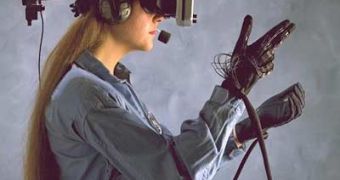Virtual Reality allows us to enter into unseen worlds, created by computers, and even to influence this unreal world. VR goes from war games to the training of surgeons or pilots. It can be applied for supervising aerial traffic, in medicine, an agreement parks, in industries and administrative domains. On the other side, VT technology can also be used in the crime world.
The first idea of VR came in 1930, when researchers created a plane simulator for pilots, provoking as most realistic as possible the sensation the pilots were on the board of a real plane. The movie unrolling to their eyes increased the impression of real.
In 1965, Ivan Sutherland came with the idea of a personal virtual world, a gear made by a small portable screen under the form of a helmet. This idea was investigated, and, in 1985, Michael McGreeveyg, a NASA collaborator, made a helmet on which he mounted two miniscreens provided with special sensors of movement tracking: they sent the information to a sensitive high performance computer.
Also in 1985, Myron Kreuger came with the Videoplace, a virtual space used by people to dance, play or juggle together, due to an interactive graphic system, even if they were found in different rooms. The gloves completed the VR equipment, being first projected by Jaron Lanier.
There are three main categories of VP technologies. The most known is that using a helmet with a TV screen, earphones, a glove (some systems use the joystick or wand rod). The helmet and the glove are attached to a computer, programmed for different sounds and graphic effects. If the system is aimed for projector or constructor engineers, then in the programmed images appear especially landscapes and buildings. The images will appear on the small screens of the helmet, placed under a certain angle, determining the formation of a 3-D image on the human brain. By putting the helmet on the head, the screen images will occupy the whole visual field, surrounding the person by virtual reality. The earphones come with the sounds belonging to those images.
The helmet and the glove (or joystick) are provided with sensors, informing the computer about the movements of the head and the hands. If we look around or turn back, the computer will assess immediately the image we see from that angle, from the center of the image. All this is produced in real time (identical with that of the real world). Using the gloves, we can grasp virtual objects, lift them up and even feel, and modify the virtual environment, like moving an object.
The second type of VR technology uses video cameras to follow the image of the user in the virtual world; here we can grasp and move objects, too. This system allows the presence of several participants.
A third type of VR projects a 3D image on a large screen, with curbed surface, creating the impression that the user is part of the virtual world. This impression can be increased by the use of 3D goggles.
The first PC game using VR was Dactyl Nightmare, in 1991. Two players could chase each other and shoot one another. This was the beginning; then computerized amusement parks appeared, with parallel virtual worlds and players that could engage in many types of games. Distorted electronic sounds completed the scene. Some people complain these parks cause them migraines and dizziness; researches showed they cause the same dependency like drugs, activating the same brain patterns.
But VR also allows persons with physical disabilities to engage in social activities inaccessible otherwise. VR also confer them the sensation of free movement.
VR is now essential in projecting, building and industries. CAD (Computer Aided Design) programs offer the possibility of 3D projection since the '70s. These VR programs enable the projectors to see the whole project and detect eventual defects or errors of concept before starting the construction. This way a lot of money is saved. The VR comes with many variants of the building and the beneficiaries can walk through the building, make an impression of what it will look like and choose the proper variant. VR projects have been used for rebuilding Berlin.
VR allows the plane manufacturers not to build costly prototypes, used before to check functionality, speed, and comfort. An ineffective VR prototype means the projecting of an improved virtual prototype, not the enormous cost of a real one, without mentioning the long period of time required for its building. NASA projected helicopters and Boeing airplanes using VR.
The VR technology helps medics investigate tumors and other conditions, and to see how drugs and other types of treatment reach the right place and work. Virtual molecules allow the researchers to see how they do react with other molecules, and this can speed the manufacturing of many drugs or the emergence of new drugs. VR helps surgeons to exercise an operation before the real act.
VR also allows the specialists to use robots in the space for fixing damages appeared on spacecrafts. Robots, called virtual dummies, could be conducted by well trained operators and by repeating the humans' movements, for entering a burning house or approach a bomb that may explode. Such robots using VR have been used for the removal of nuclear waste. They could be used for removing contamination sources, like toxic gas emanations, or to close the defect blocks of nuclear centrals. Such robots could be used for non-healthy activities, like soldering.
VR helps soldiers simulate whole real fights. Before the Gulf War, American troops viewed VR programs with the Iraq's aerial space and terrestrial objectives.
Already, VR allows us to travel on the surface of Mars, due to images delivered by spacecrafts. One day, we could just walk through a virtual supermarket to make our shopping that will be delivered to us without even getting out of the house.

 14 DAY TRIAL //
14 DAY TRIAL //